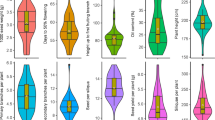Summary
The genetical components of family means and variances, simply and reliably estimated in the first few generations of any breeding programme initiated from a cross between two inbred lines, are all that is required to predict the distribution of the inbred lines that can be derived by single seed descent from the F2 of such a cross. We can, therefore, determine the probability of obtaining inbreds that fall outside of the parental range or of exceeding the F1 if it shows heterosis, by any amount we care to specify.
While epistasis, genotype × environmental interactions and linkage may at first sight appear to seriously disturb any such prediction they can all be accommodated. In practice only epistasis is expected and found to produce disturbances of a sufficient magnitude to justify making allowance for its presence in making these predictions. This is because it leads to asymmetry in the distribution of derived inbreds relative to the initial inbred parental means.
The predictive power of this new approach is demonstrated on two complete breeding cycles, each initiated by a cross between two pure-breeding varieties of Nicotiana rustica and culminating in the production of over 100 recombinant, pure-breeding lines. The ability of the analysis to discriminate between two crosses on the basis of their probabilities of producing inbred lines that fall outside of their parental range is also demonstrated. By using analyses of this kind there is no reason why we need ever go beyond the F2 of an inbreeding programme without a fairly clear idea of the outcome.
Similar content being viewed by others
Article PDF
References
Breese, E L. 1954. Continuous variation in higher plants. Ph.D. Thesis, University of Birmingham.
Bucio-Alanis, L. 1966. Environmental and genotype-environmental components of variability. I. Inbred lines. Heredity, 21, 387–397.
Bucio-Alanis, L, and Hill, J. 1966. Environmental and genotype-environmental components of variability. II. Heterozygotes. Heredity, 21, 399–405.
Bucio-Alanis, L, Perkins, Jean M, and Jinks, J L. 1969. Environmental and genotype-environmental components of variability. V. Segregating generations. Heredity, 24, 115–127.
Eaves, L J, and Brumpton, R J. 1972. Factors of covariation in Nicotiana rustica. Heredity, 29, 151–175.
Jayasekara, N E M, and Jinks, J L. 1976. Effect of gene dispersion on estimates of components of generation means and variances. Heredity, 36, 31–40.
Jinks, J L, and Perkins, Jean M. 1969. The detection of linked epistatic genes for a metrical trait. Heredity, 24, 465–475.
Jinks, J L, and Perkins, Jean M. 1970. A general method for the detection of additive dominance and epistatic components of variation. III. F2 and backcross populations. Heredity, 25, 419–429.
Jinks, J L, and Perkins, Jean M. 1972. Predicting the range of inbred lines. Heredity, 28, 399–403.
Jinks, J L, Perkins, Jean M, and Breese, E L. 1969. A general method of detecting additive, dominance and epistatic variations for metrical traits. II. Application to inbred lines. Heredity, 24, 115–127.
Kearsey, M J, and Jinks, J L. 1968. A general method of detecting additive, dominance and epistatic variation for metrical traits. I. Theory. Heredity, 23, 403–409.
Mather, K, and Jinks, J L. 1971. Biometrical Genetics. Chapman and Hall, London.
Mather, K, and Vines, A. 1952. The inheritance of height and flowering time in a cross of Nicotiana rustica, from Quantitative Inheritance, ed. E. C. Reeve and C. H. Waddington, pp. 49–80. H.M.S.O., London.
Perkins, Jean M, and Jinks, J L. 1968. Environmental and genotype-environmental components of variability. III. Multiple lines and crosses. Heredity, 23, 339–356.
Perkins, Jean M, and Jinks, J L. 1970. Detection and estimation of genotype-environmental, linkage and epistatic components of variation for a metrical trait. Heredity, 25, 157–177.
Perkins, Jean M, and Jinks, J L. 1973. The assessment and specificity of environmental and genotype-environmental components of variability. Heredity, 30, 111–126.
Pooni, H S, and Jinks, J L. 1976. The efficiency and optimal size of triple test cross designs for detecting epistatic variation. Heredity, 36, 215–227.
Author information
Authors and Affiliations
Rights and permissions
About this article
Cite this article
Jinks, J., Pooni, H. Predicting the properties of recombinant inbred lines derived by single seed descent. Heredity 36, 253–266 (1976). https://doi.org/10.1038/hdy.1976.30
Received:
Issue date:
DOI: https://doi.org/10.1038/hdy.1976.30
This article is cited by
-
Identification and mapping of genetic locus conferring resistance to multiple plant viruses in soybean
Theoretical and Applied Genetics (2022)
-
Mapping QTL associated with partial resistance to Aphanomyces root rot in pea (Pisum sativum L.) using a 13.2 K SNP array and SSR markers
Theoretical and Applied Genetics (2021)
-
The first genetic map for yellow lupin enables genetic dissection of adaptation traits in an orphan grain legume crop
BMC Genetics (2019)
-
Genetic analysis and fine mapping of phosphorus efficiency locus 1 (PE1) in soybean
Theoretical and Applied Genetics (2019)
-
Predicting genetic variance in bi-parental breeding populations is more accurate when explicitly modeling the segregation of informative genomewide markers
Molecular Breeding (2015)



